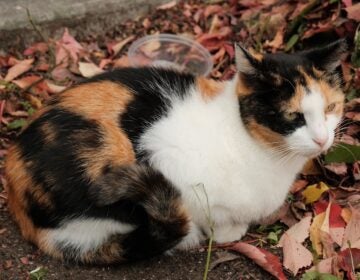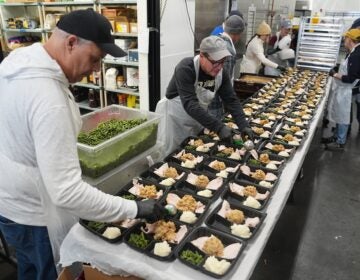Philadelphia, ‘The City of Neighborhoods’
-
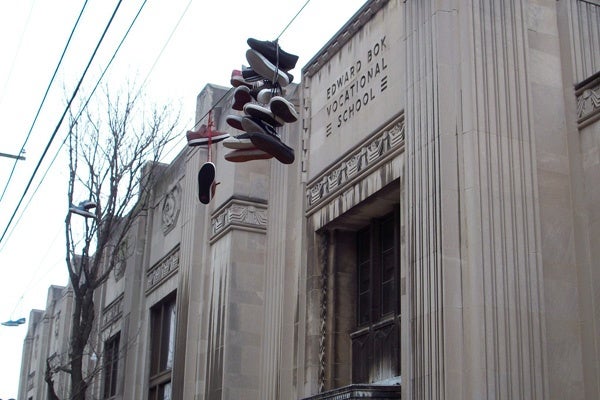
A familiar sight in South Philadelphia, shoes are flung up to hang from power lines in front of Edward Bok High School, at 9th and Mifflin streets. (Eric Walter/WHYY)
-
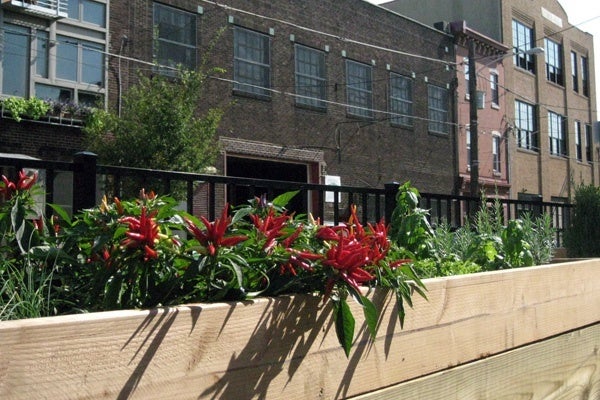
Chili peppers grow in a South Philadelphia community garden
-
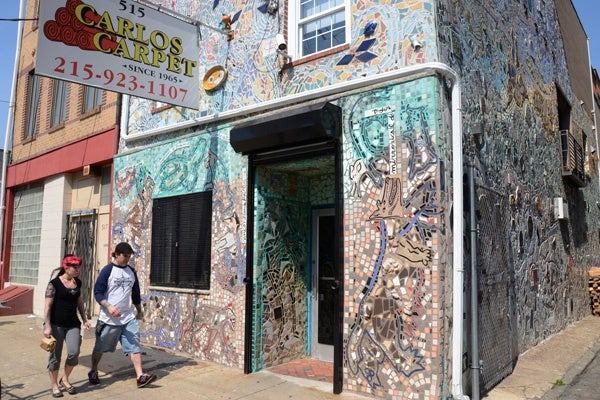
Isaiah Zagar's mosaic work decorates many South Philadelphia residences and businesses. (Max Matza/ for NewsWorks)
-
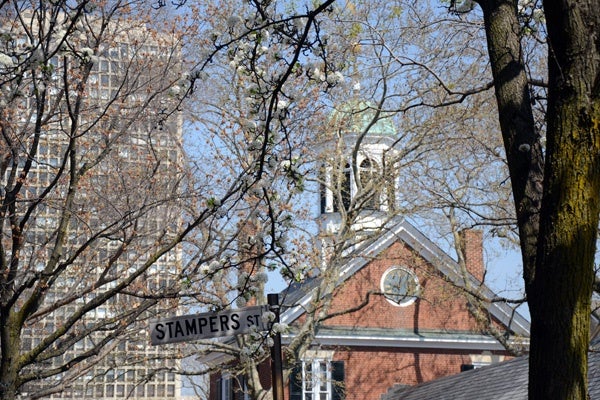
Part of the Headhouse Square Farmers Market is visible from the corner of 2nd and Stampers streets in Society Hill. (Max Matza/for NewsWorks)
Curiously, the moniker of “The City of Neighborhoods” is carried by the city William Penn founded instead of one of the European cities where firmly established neighborhoods existed long before Philadelphia was even a figment in Penn’s imagination.
William Penn, the founder of Philadelphia, grew up in the Tower Hill section of London, one of the many storied neighborhoods in the capital of England.
Before Penn set foot on the Delaware River shoreline in October 1682, he lived in a number of European cities including Paris, Dublin and Amsterdam. Each of those centuries-old European cities contained a rich fabric of fabled neighborhoods.
Curiously, the moniker of “The City of Neighborhoods” is carried by the city Penn founded instead of one of the European cities where firmly established neighborhoods existed long before Philadelphia was even a figment in Penn’s imagination.
New York City, formally founded before Penn’s arrival in America, has hundreds more identified neighborhoods than Philadelphia, judging by the list of nearly 200 neighborhood names compiled by the Philadelphia City Department of Records.
NYC’s Department of City Planning references America’s largest city merely as “A City of Neighborhoods” — not using the distinguishing word “The.” Boston, Chicago, St. Louis, and other cities also regard themselves as “a” City of Neighborhoods.
A residential character
The origins of Philadelphia’s claim are unclear. The city was regarded as “The City of Homes” as far back as the 1870s, and an 1893 book termed Philadelphia “a city of residences” with praise for the legacy of homeownership by “employers and employees” dating from Penn’s arrival. A 1976 booklet on the historical development of Philadelphia neighborhoods published by Philadelphia’s City Planning Commission stated, “Philadelphia as a city of neighborhoods has antecedents as far back as the city’s founding.”
Whether the savvy snagging of an adroit marketing slogan or sheer happenstance, the reputation of “The City of Neighborhoods” is consistent with the fact that Philadelphia historically has defined itself through its residential character.
Implicit in the “City of Neighborhoods” dynamic is the intense pride Philadelphians hold about the distinct residential areas comprising this city. Philadelphians love their city but they particularly love those sections of their city where they were born, raised and in many instances continue to live.
Many of the current neighborhoods around Philadelphia existed as separate boroughs, districts and townships in the County of Philadelphia before absorption into the city via the 1854 Act of Consolidation. Before consolidation, Philadelphia’s city boundaries extended only as far as William Penn’s original plan, from the Delaware River to the Schuylkill and from Vine to South Streets.
Consolidation brought into the city neighborhoods such as historic Germantown in the northwest, formally founded one year before William Penn’s arrival, and the Spring Garden community on the city’s northwest edge.
The distinction of being Philadelphia’s oldest continuously occupied neighborhood belongs to Tacony, with records of residents dating from a decade prior to William Penn’s arrival. This neighborhood located along the Delaware River, in what is now Philadelphia’s Lower Northeast section, is near the place where Penn made a Treaty of Peace with the Native Americans who originally inhibited the Philadelphia region.
A changing character
Neighborhoods appear to be stable, yet they are continually changing. This is evident in Society Hill, the lauded upscale community of colonial-era homes adjacent to Independence National Historical Park.
The name Society Hill originated with the Free Society of Traders, a colonial-era merchant’s society, and once applied to the entire region from today’s Pine Street down to Christian Street. The name fell out of use by the nineteenth century, but assumed new life during the 1950s period of urban renewal.
Urban renewal transformed Society Hill from a hardscrabble residential area filled with commercial buildings into an elite enclave. However that renewal also triggered removal of Philadelphia’s oldest African-American community dating from colonial times — the area examined in Dr. W.E.B. DuBois’ seminal 1899 book, “The Philadelphia Negro,” prepared as sociological research for the University of Pennsylvania.
The changing character of this city’s neighborhoods is also evident in North Philadelphia’s now overwhelmingly African-American Strawberry Mansion section, which housed Philadelphia’s largest Jewish community during the first half of the twentieth century.
Philadelphia’s character as a “City of Neighborhoods” also developed from immigration and absorption of new populations. Successive waves of immigrants from across Europe, blacks migrating from the South, and Hispanics (primarily Puerto Ricans) added distinctive imprints to the complexions of neighborhoods.
Interestingly, Philadelphia’s famous nickname — the “City of Brotherly Love,” derived from the translation of the Greek name Penn gave his city — also masks a history of un-neighborly turmoil.
Philadelphia’s earliest race riots targeted African Americans in today’s Society Hill in the early nineteenth century, and by the 1840s anti-Catholic sentiment targeted Irish immigrants in Kensington and Southwark.
In the 1950s-1960s efforts to preserve rare integration became defining struggles in neighborhoods like Mt. Airy, located in Philadelphia’s leafy Northwest section. These were contemporary challenges for a neighborhood with a long history. Mt. Airy inherited its name from the mansion owned by a Colonial-era Chief Justice of Pennsylvania’s Supreme Court, then expanded residentially in the late 1800s as trolley and commuter train lines created links to Center City.
Pride of place
Surprisingly for a city steeped in history, the neighborhood-memory of many Philadelphians extends back for only a couple of decades.
Few among the thousands coming to the Sports Complex in South Philadelphia yearly to cheer the city’s professional baseball team are aware that Philadelphia’s century-plus long baseball tradition began in North Philadelphia during the 1880s. Two teams from that era remain active in Major League Baseball including the beloved Phillies.
Today many see South Philadelphia as historically the Italian section of the city. Few are aware of that area’s origins with Swedish settlers as evidenced by the Gloria Dei (Old Swedes’) Church, the oldest church in Pennsylvania. And along with Italians, the area has growing Mexican and Southeast Asian populations.
Philadelphians hold a heartfelt loyalty about their neighborhoods. And that loyalty radiates through the collective psyche of the city that adores local cuisine like juicy cheesesteaks, and wild support for professional sports teams reflects in the name of the mascot of Philadelphia’s MLB team: the “Phillie Phanatic.”
Although Philadelphia’s population fluctuates and facial features of its communities change, that pride in being a part of a particular neighborhood remains resilient.
—
Linn Washington Jr. is associate professor of journalism at Temple University and co-director of PhiladelphiaNeighborhoods.com.
This essay is published in partnership with the Encyclopedia of Greater Philadelphia project and the Historical Society of Pennsylvania, with support from the Pennsylvania Humanities Council.
WHYY is your source for fact-based, in-depth journalism and information. As a nonprofit organization, we rely on financial support from readers like you. Please give today.



